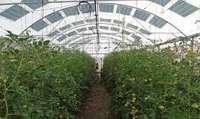Introduction
Growing food sustainably presents many challenges, such as climate change, integrative pest control, meeting crop irrigation requirements, escalating energy costs, and an unreliable electricity supply. Greenhouses offer a solution by extending crop seasons, shielding crops from extreme weather, and excluding pests—one of the major drivers for adopting protected agriculture structures for high-value crops (tomatoes, peppers, and other horticultural crops). However, greenhouses also introduce new energy demands for heating, cooling, and irrigation. These challenges are especially pronounced in areas with limited electrical grid access.
Why solar for greenhouses?
Solar energy stands out as an effective solution for powering greenhouses, especially in regions where traditional energy sources are scarce or expensive. The advantages include:
High solar irradiance in energy-poor areas: Many regions with limited access to electricity receive abundant sunlight, making solar energy a logical choice for powering agricultural operations.
Load matching: The peak energy demand for greenhouses, particularly for irrigation and ventilation, often coincides with peak sunlight hours. This natural alignment makes solar energy efficient.
Modularity: Solar systems are highly scalable, allowing farmers to tailor installations to the size of their operations from small backyard plots to mid-sized commercial farms.
Field insights: Eastern Africa
Recent pilot projects in Eastern Africa demonstrate the transformative potential of integrating photovoltaic (PV)8 systems into small and mid-sized greenhouses. Even modest installations (1 to 2 kW) have enabled farmers to:
- power fans, drip irrigation systems, and low-energy pumps;
- extend production into hotter or colder months, improving both food security and income stability.

Figure 16. Solar paneled greenhouse with tomato crop. Source: Ruth Gassim
Example: In Ethiopia, a 1.5 kW semi-transparent PV system on a 300 m² greenhouse powered irrigation pumps and ventilation fans while providing optimal light levels for tomatoes (Figure 16). Farmers reported year-round production and reduced pest incidence.
Lessons learned
Design matters
The orientation (ideally North-South) and material of the greenhouse significantly affect both agricultural performance and solar energy output. Semi-transparent PV panels can be integrated into greenhouse roofs, generating electricity while modulating light for optimal plant growth.
For smallholder farmers, plastic covering should be at least 150 to 200 microns thick for durability. Local suppliers are often found through agricultural cooperatives or the Ministry of Agriculture.
Storage vs. smart use
Battery storage remains a costly component. Many successful systems operate by synchronizing energy use with sunlight availability, such as irrigating during the day rather than relying on stored power. Innovative approaches like repurposing drone components for battery systems are being explored to reduce costs.
Local capacity is key
The success of solar-greenhouse projects depends on the availability of local technicians who can install and maintain the systems. Building local technical capacity should be a priority alongside scaling up solar integration.
Policy and incentives
Government policies such as subsidies or import duty exemptions for solar components facilitate the adoption of solar-powered greenhouses. Advocacy for supportive policies can be transformative in scaling these solutions.
Implications for the network
Solar-powered greenhouses can enhance food production in energy-poor settings, reduce reliance on diesel generators and grid power, lower carbon emissions, and improve resilience to energy price fluctuations. While each context is unique, sharing innovations and lessons learned across regions can accelerate adaptation and effectiveness in agri-energy integration.
Call to action
If you are exploring similar ideas or have encountered innovations in agricultural energy integration, your experiences are valuable. Sharing knowledge across contexts helps us all adapt more rapidly and effectively to the challenges of sustainable food production.
We encourage network members to share experiences successes and setbacks through dedicated discussion spaces on ECHO Conversations.